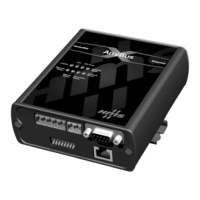
Do you have a question about the HMS AnyBus-X AB7607 and is the answer not in the manual?
| Category | Gateway |
|---|---|
| Manufacturer | HMS Industrial Networks |
| Protection Class | IP20 |
| Weight | Approx. 150 g |
| Model | AB7607 |
| Ethernet Interface | 10/100 Mbit, RJ45 |
| Power Supply | 24 VDC |
| Power Consumption | Typically 2.5 W |
| Storage Temperature | -40 to +85 °C |
| Relative Humidity | 5% to 95% (non-condensing) |
| Enclosure | Plastic |
| Mounting | DIN rail |
| Certifications | CE, UL |
Guidance on navigating and understanding the manual's content.
Critical safety and usage advisories for the Anybus-X module.
Lists external documents for further technical reference.
Provides a general introduction to the Anybus-X Ethernet to DeviceNet Gateway.
Explains the internal data flow and communication mechanism of the module.
Details the specific capabilities and functionalities related to the DeviceNet interface.
Details the specific capabilities and functionalities related to the Ethernet interface.
Describes the physical aspects, connectors, and indicators of the Anybus-X module.
Outlines essential prerequisites and safety guidelines for module installation.
Illustrates and explains the physical connections for power and network interfaces.
Step-by-step instructions for connecting the DeviceNet network cable to the module.
Introduces the primary software tool for configuring the Anybus-X module's settings.
Details methods for setting up IP addresses, subnet masks, and gateway for Ethernet.
Explains how to configure the DeviceNet interface, including MAC ID and baud rate.
Describes the process of mapping I/O data for DeviceNet communication.
Guide to configuring DeviceNet nodes using RSNetWorx software.
Instructions for accessing and managing files on the module via Ethernet.
Explains the Anybus-X's role as a DeviceNet Master or slave.
Details how the module manages communication with connected DeviceNet slave devices.
Describes the two operating modes (Run and Idle) and their impact on module behavior.
Explains the feature that automatically replaces faulted DeviceNet slave devices.
Highlights key functionalities of the EtherNet/IP adapter class.
Explains the different types of CIP messaging supported by the module.
Details the format and content of the input data assembly for EtherNet/IP.
Details the format and content of the output data assembly for EtherNet/IP.
Lists the Modbus/TCP commands that the Anybus-X module supports.
Describes the addressing schemes used for accessing data via Modbus/TCP.
Outlines the security levels and access controls for the module's file system.
Explains the structure and purpose of various configuration files stored on the module.
Describes the HTML files used for web-based configuration and status display.
Information on the pre-configured user accounts for administration and normal access.
Details how to use the FTP server for file management and access.
Explains the functionality of the embedded web server and SSI capabilities.
Explains the meaning of the various LED indicators on the module.
Describes the status LEDs for the DeviceNet network interface.
Describes the status LEDs for the Ethernet network interface.
Information on accessing web pages for module status and diagnostic data.
Details operating and non-operating temperature ranges for the module.
Lists the operating voltage and current requirements for the module.
Provides physical dimensions and mechanical ratings of the module.
Describes the power connector pinout and specifications.
Details the DeviceNet connector pinout and signal assignments.
Provides the pinout for the Ethernet RJ45 connector.
Legal disclaimers and limitations on the manufacturer's warranty coverage.
Information on how to obtain technical support and assistance.
Provides contact details for HMS Industrial Networks.